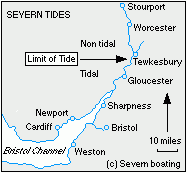Today, weirs near Gloucester hold back the daily tides except at high Spring tides *.
The high Spring tides overtop the weirs and make the River Severn tidal as far as Upper Lode Lock, near Tewkesbury.
Around high water, severe turbulence occurs near the approach to Gloucester lock.
Boats should avoid passage at this time.




